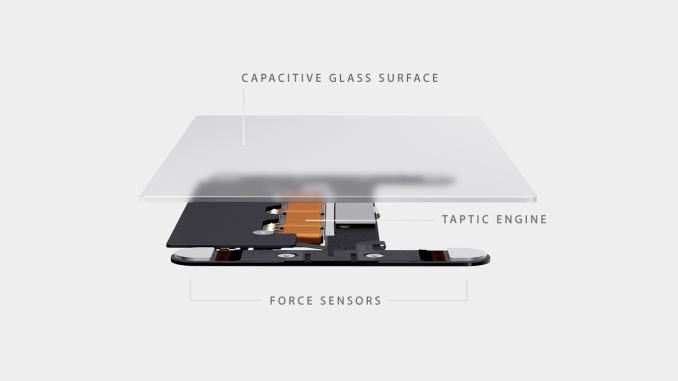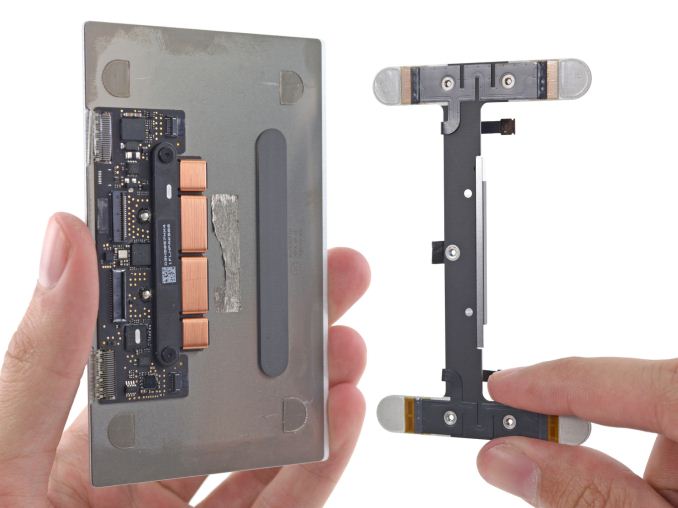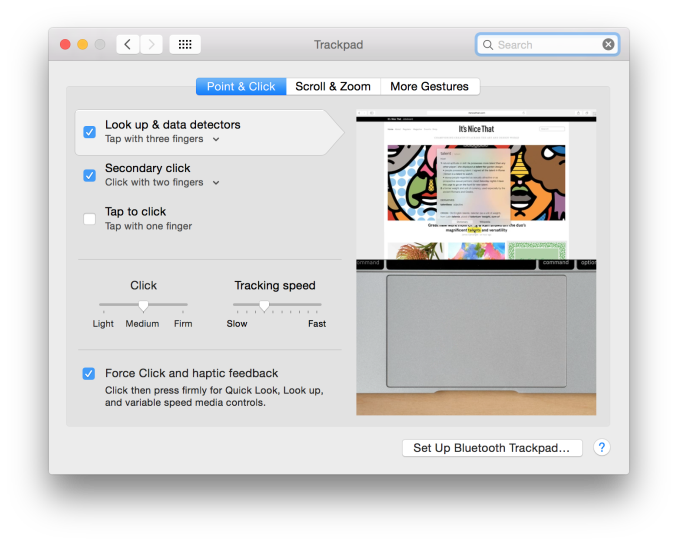The 2015 MacBook Review
by Ryan Smith on April 14, 2015 10:15 AM ESTForce Touch Trackpad
Along with Apple’s changes to their keyboard, the company has also gone in and significantly reworked their trackpad. The new Force Touch Trackpad represents the biggest change to Apple’s trackpad design since the creation of the capacitive, multi-touch pivoting trackpad introduced on the unibody MacBook Pro. In putting together the Force Touch Trackpad, Apple has significantly reworked the internals of the trackpad, creating a trackpad that behaves a lot like their traditional trackpad with some new features, but under the hood relies on some very different mechanisms.
The big change here is that Apple has done away with the traditional pivot and switch mechanism. With pivot and switch, the capacitive trackpad surface would act like a small touchscreen, and underneath it was a switch to register when the trackpad was pressed down. Mechanically the trackpad pivoted from the top (Apple likes to compare it to a diving board), with the trackpad inferring what action to take based on the combination of the capacitive readings and the switch reading. Multi-finger gestures would rely solely on the capacitive layer, primary/secondary clicks would be based on the number of fingers in use when the switch was actuated, etc.
The Force Touch Trackpad on the other hand eliminates the pivot and switch mechanism in favor of a combination of an electromagnet and force/pressure sensors. The pressure sensors essentially replace the physical switch, allowing the trackpad to tell when it has been pressed based on the amount of pressure, and thanks to the pressure sensors it can now tell how hard it has been pressed as opposed to the binary nature of the physical switch. Meanwhile without a physical switch in place to provide the clicking sensation and feedback of pressing down on the touchpad, Apple’s electromagnet – the Taptic Engine – activates to simulate the feeling and noise of pressing a switch.
Update 04/15/2015: iFixit has a great shot of the trackpad's internals, including a good look at just how big the electromagnet/taptic engine really is.
The end result is that the MacBook’s trackpad is among the first wave of devices that ships with Apple’s next generation trackpad and the enhanced capabilities that go with it. Ignoring the pressure sensitivity for a moment (we’ll get back to it), replacing the pivot and switch for an electromagnet works shockingly well. From a touch & feel standpoint the Force Touch Trackpad feels virtually identical to a traditional trackpad, to the point where it’s more than a bit uncanny. In practice you are not actually triggering a switch nor is the trackpad really moving (technically it’s deforming ever so slightly), but it sure feels like you’re working a switch. Apple has clearly done their homework on getting an electromagnet to emulate a switch, to great results. Meanwhile they don’t have the trackpad’s acoustics precisely matching a switch, but the resulting pinball-machine like plunk is close enough to a click that I don’t imagine anyone will mind the difference.
One side benefit of this change is that the trackpad feels the same throughout, and unlike the pivoting trackpad does not require more or less force depending on where you are relative to the pivot point. The variable force required has never been a major problem in my experience, but it is nice to no longer need to worry about where your fingers are relative to the top, and consequently how much force you need to use.
However the bigger deal is that by making the amount of force required to click consistent throughout the entire trackpad, Apple can now use the amount of pressure applied as another input, making the trackpad pressure-sensitive. The underlying pressure sensors and electromagnet are by default programmed to have two levels of feedback – a shallower press is equivalent to a click – and a deeper press brings about the pressure-sensitive “Force Click.” What force clicking does depends on the application, and right now it’s clear that Apple is still experimenting with what they can do with pressure sensitivity. The most obvious uses include line thickness in drawing applications, but the company is also using it for things such as variable speed fast forward and rewinding in QuickTime/iMovie. At times the force click is treated like a 3rd (tertiary) click, and other times the result is based on variable pressure. Since this is a new (and uncommon) feature there’s no global action assigned to the force click – nor does it behave as a middle click on a regular mouse – so what happens is up to the application.
In implementing force click and the Force Touch Trackpad, Apple does offer the ability to control the amount of pressure required and whether force click is active. With force click deactivated the trackpad behaves more or less identical to a traditional trackpad with a single click level. Meanwhile the click pressure setting is interesting, though I’m not entirely convinced it’s all that effective. Short of the tools to actually measure click pressure, I’m not so sure Apple is changing the amount of pressure required to trigger a click so much as they’re changing how hard the electromagnet vibrates. The feedback change is certainly very subtle going from light to firm, and if there is a change in the amount of pressure required then it is certainly equally subtle.
Ultimately whether the Force Touch Trackpad is a major upgrade or not is going to depend on a user’s ability to make use of the force click features. Even turned off, the new trackpad is essentially an improved version of the old trackpad without the minor drawbacks of the pivot mechanism. But with the force click turned on, then it brings new (though not always useful) actions to the trackpad that in turn makes it a bigger upgrade over the old trackpad.
In any case, the MacBook along with the 2015 MacBook Pro 13” are the first wave of devices to implement the new Force Touch Trackpad. Given its expanded capabilities I would expect Apple to eventually replace many (if not all) of their trackpads with this new design. Certainly the 15” MacBook Pro is a likely candidate, as is a future version of the Magic Trackpad. What remains to be seen is whether the next MacBook Air also gets this new trackpad, or if Apple withholds it to keep the products differentiated and to keep the costs of the MacBook Air down.














354 Comments
View All Comments
tpoccu - Friday, April 17, 2015 - link
Did you write something similar about the original MacBook Air, you know the one that cost about 3 times as much as this, also had only USB, video out (micro-DVI if memory serves which nothing else ever used), and a headphone jack, and had atrocious performance compared to its contemporaries? The same MacBook Air that only one redesign later would go on to become the defacto standard for how mainstream laptops are built now. I suppose it is easier to rant without any use for foresight.Schickenipple - Monday, April 20, 2015 - link
Seriously, BittenRottenApple: You need to get laid.All companies will do whatever they can to sell whatever they can because they want to make money and people will continue to buy their stuff. If being 'informed' means that consumers will turn into you and start spouting useless crap on technology forums for hours at a time, then they would probably rather pay a lot of money for a new OS X device and have some fun. Even if it is just a sweet-looking netbook. Grow up and quit wasting your energy on this stuff.
Also: Change your username to something less troll-like and cliché. We all knew exactly how your comment would read before even reading it.
karpodiem - Monday, April 20, 2015 - link
I laughed through reading some of this, but agreed with much of it than I disagreed with.Spot on
star-affinity - Friday, April 24, 2015 - link
”They eliminate all ports except for one outdated USB port?”How is it outdated? USB 3.1 barely just hit the market.
”Other operating systems can be installed on just about any computer you can slap together, whereas OSX is specifically and deliberately designed to be non-functional on ANYTHING that isn’t made by apple.”
Not true – OS X works very well on my Hackintosh with very few modifications.
I wouldn't get this MacBook, but the recently updated 13" MacBook Pro looks quite nice in my book. I think OS X is worth a lot. There's less hassle with it overall (compared to Windows) and I can work much more switfly using it (less actions/steps needed for most common tasks). I say this working at an IT department at an office where there's computers running both Windows and OS X.
You don't have to like Apple or their products, but I don't thinks your criticism (or should I say rant) is very balanced.
sunnohh - Saturday, April 25, 2015 - link
Computers last 2 years for most Apple users 3 tops. Source former Apple certified repair tech. 1300 isn't that much money. And as a dedicated PC gamer with a Titan rig 24 USB ports; gigs of ram and inches of monitor; this MacBook seems like a great little second machine. I prefer portability in a laptop to power and as a somewhat fancy individual there are literally zero times I would ever need a port on a laptop other than power, which with an 8 hr battery can be discretely done from home. Some people have grown up jobs and need shiny Apple products and Mercedes cars to fit in at work.I am an extremely informed PC builder yet I choose Apple products because they are astonishingly high performing elegant bits of jewelry/PC. Ever compare the hinges on a MacBook to a Lenovo or asus? Good Christ. Apple sound quality? 100% better then the next best PC or android bar none. And I've tried everything and seen every measurement not even close. Color quality check.
Sure it's a cult but it's reasonably priced for the quality, especially compared to a Benz. And the best part of Apple ownership is I can have Apple pie and windows and it's ok. Seriously it's fucking awesome.
vista980622 - Wednesday, May 20, 2015 - link
There are some valid points there, and as a semi-professional video editor + graphics designer, I definitely know I'm not its' target audience. The new MacBook is designed for people who use computer differently than we do, and I'm glad a lot of my friends and people around me love the tiny laptop that is beautiful and light.vista980622 - Wednesday, May 20, 2015 - link
And I do enjoy the XPS 13 :)farhanshaikh74 - Sunday, May 24, 2015 - link
I was die hard apple fan from so many years and used to propagate apple products to such an extent that I am called Late Steve Job's best marketing guy in my hospital!However over last three years as Apple has stopped producing simple MacBook pro which are upgradeable (like mid 2012 MacBook pro) with DVD drive, I am feeling their vision of "design should include how things work" philosophy is losing its sheen.
Now they are selling only MacBook Retina, no non-retina laptops!, No laptops with DVD drive!! No laptops with 8GB RAM with normal Hard disk Drive which is upgradeable!!!
They are forcing us to buy ONLY Retian, with a fixed Flash drive which is meagre 126Gb or 256 GB, and those which come with 500 GB are exorbitantly costly.
They are forcing us to use iCloud for storage, without realising that in many parts of the world accessibility to WiFi and iCloud.
I am serious restricted by fixed 256GB Flash drive on my late 2013 Retina MacBook pro as I bought this expensive laptop, but struggling for space and the Flashdrive is not upgradeable!!
From last one week I am seriously considering Apple products and going back to Windows.
The design team in Apple is ignorant to a large population, who loves apple products and have moderate budget, they are busy catering only to high end products at premium price.
If this continues, they will find very few people using iOS in future and Apple will die its own death.
This is serious, as a die hard fan of Apple like me is writing such a comment!
Stimpak_Addict - Tuesday, June 9, 2015 - link
Check out Thunderbolt 3. It seems like they made this form factor to accommodate it once it's finalized (and hopefully they'll include at least 2 Thunderbolt 3 ports with the next iteration).jdw1992 - Sunday, June 14, 2015 - link
I have to point out a serious area you lack on knowledge. You berate USB as being outdated compared to thunderbolt. If you were speaking of anything but USB C you would be correct. However, and I do not know why Apple did not point this out, USB C and thunderbolt are now one and the same. Intel announced that the standard known as Thunderbolt is now part of the USB C standard. In other words, Apple is the first to land the next generation of peripheral ports, the most versatile and fast one to date.